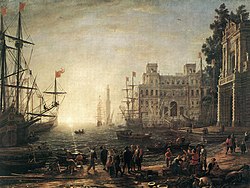Port


A port is a facility for receiving ships and transferring cargo to and from them. They are usually situated at the edge of an ocean, sea, river, or lake. Ports often have cargo-handling equipment such as cranes and forklifts for use in loading/unloading of ships, which may be provided by private interests or public bodies. Often, canneries or other processing facilities will be located very close by.
The term 'port' is used for ports that handle ocean-going vessels, and river port is used for facilities that handle river traffic. Sometimes a port on a lake or river also has access to the ocean, and is then referred to as an inland port. A fishing port is a type of port or harbor facility particularly suitable for landing and distributing fish. A dry port is a term sometimes used to describe a yard used to place containers or conventional bulk cargo, usually connected to a seaport by rail or road.
The presence of deep water in channels or berths, the provision of protection from the wind, waves and storm surges and access to intermodal transportation such as trains or trucks are critical to the functioning of seaports and river ports.
Cargo containers allow for efficient transport and distribution as each product, box and bulk cargo do not need to be loaded individually at each transportation point, making the loading and unloading process more efficient. Cargo can be sealed at point of origin, transported via intermodal transport, before being stacked and loaded on container ships. These are then ultimately opened at final point of resale or destination. This is a vital part of modern retailing Just in Time Delivery strategies.

Seaports and river ports are often equipped with large cranes for the loading and unloading of containers from container ships. These are usually operated by stevedores. Pilots and tugboats are also used to safely maneuver the ships in tight quarters.
Major ports

- Port of Antwerp
- Port of Busan
- Port of Chiba
- Port of Dubai
- Port of Erdemir
- Port of Hamburg
- Port of Hong Kong
- Port of Houston
- Port of Incheon
- Port of Kaohsiung
- Port Klang
- Port of Long Beach
- Port of Los Angeles
- Port of Mumbai
- Port of Mundra
- Port of New York/New Jersey
- Port of Rotterdam
- Port of Seattle
- Port of Shanghai
- Port of Shenzhen
- Port of Singapore
- Port of South Louisiana
- Port of Vancouver
- Port of Bilbao
- Port of Vigo
